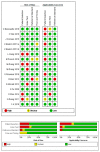Characterisation of Prostate Lesions Using Transrectal Shear Wave Elastography (SWE) Ultrasound Imaging: A Systematic Review
- PMID: 33558449
- PMCID: PMC7795187
- DOI: 10.3390/cancers13010122
Characterisation of Prostate Lesions Using Transrectal Shear Wave Elastography (SWE) Ultrasound Imaging: A Systematic Review
Abstract
Background: ultrasound-based shear wave elastography (SWE) can non-invasively assess prostate tissue stiffness. This systematic review aims to evaluate SWE for the detection of prostate cancer (PCa) and compare diagnostic estimates between studies reporting the detection of all PCa and clinically significant PCa (csPCa).
Methods: a literature search was performed using the MEDLINE, EMBASE, Cochrane Library, ClinicalTrials.gov, and CINAHL databases. Studies evaluating SWE for the detection of PCa using histopathology as reference standard were included.
Results: 16 studies including 2277 patients were included for review. Nine studies evaluated SWE for the detection of PCa using systematic biopsy as a reference standard at the per-sample level, with a pooled sensitivity and specificity of 0.85 (95% CI = 0.74-0.92) and 0.85 (95% CI = 0.75-0.91), respectively. Five studies evaluated SWE for the detection of PCa using histopathology of radical prostatectomy (RP) specimens as the reference standard, with a pooled sensitivity and specificity of 0.71 (95% CI = 0.55-0.83) and 0.74 (95% CI = 0.42-0.92), respectively. Sub-group analysis revealed a higher pooled sensitivity (0.77 vs. 0.62) and specificity (0.84 vs. 0.53) for detection of csPCa compared to all PCa among studies using RP specimens as the reference standard.
Conclusion: SWE is an attractive imaging modality for the detection of PCa.
Keywords: prostate cancer; shear wave elastography; ultrasound.
Conflict of interest statement
The authors declare no conflict of interest.
Figures





Similar articles
-
Clinical Trial Protocol: Developing an Image Classification Algorithm for Prostate Cancer Diagnosis on Three-dimensional Multiparametric Transrectal Ultrasound.Eur Urol Open Sci. 2023 Jan 26;49:32-43. doi: 10.1016/j.euros.2022.12.018. eCollection 2023 Mar. Eur Urol Open Sci. 2023. PMID: 36874606 Free PMC article.
-
Diagnostic Value of Transrectal Shear Wave Elastography for Prostate Cancer Detection in Peripheral Zone: Comparison with Magnetic Resonance Imaging.J Endourol. 2020 May;34(5):558-566. doi: 10.1089/end.2019.0902. Epub 2020 Apr 21. J Endourol. 2020. PMID: 32164448
-
Multiparametric ultrasound: evaluation of greyscale, shear wave elastography and contrast-enhanced ultrasound for prostate cancer detection and localization in correlation to radical prostatectomy specimens.BMC Urol. 2018 Nov 8;18(1):98. doi: 10.1186/s12894-018-0409-5. BMC Urol. 2018. PMID: 30409150 Free PMC article. Clinical Trial.
-
Value of shear wave elastography for diagnosis of primary prostate cancer: a systematic review and meta-analysis.Med Ultrason. 2019 Nov 24;21(4):382-388. doi: 10.11152/mu-2051. Med Ultrason. 2019. PMID: 31765445
-
Multiparametric MRI in detection and staging of prostate cancer.Dan Med J. 2017 Feb;64(2):B5327. Dan Med J. 2017. PMID: 28157066 Review.
Cited by
-
Clinical Trial Protocol: Developing an Image Classification Algorithm for Prostate Cancer Diagnosis on Three-dimensional Multiparametric Transrectal Ultrasound.Eur Urol Open Sci. 2023 Jan 26;49:32-43. doi: 10.1016/j.euros.2022.12.018. eCollection 2023 Mar. Eur Urol Open Sci. 2023. PMID: 36874606 Free PMC article.
-
Diagnostic value of endobronchial ultrasound elastography in differentiating between benign and malignant hilar and mediastinal lymph nodes: a retrospective study.Quant Imaging Med Surg. 2023 Jul 1;13(7):4648-4662. doi: 10.21037/qims-23-241. Epub 2023 Jun 5. Quant Imaging Med Surg. 2023. PMID: 37456274 Free PMC article.
-
Artificial Intelligence System for Predicting Prostate Cancer Lesions from Shear Wave Elastography Measurements.Curr Oncol. 2022 Jun 10;29(6):4212-4223. doi: 10.3390/curroncol29060336. Curr Oncol. 2022. PMID: 35735445 Free PMC article.
-
A prospective study on using shear wave elastography to predict the ypT0 stage of rectal cancer after neoadjuvant therapy: a new support for the watch-and-wait approach?Front Mol Biosci. 2024 Apr 26;11:1402498. doi: 10.3389/fmolb.2024.1402498. eCollection 2024. Front Mol Biosci. 2024. PMID: 38737335 Free PMC article.
-
ProCUSNet: Prostate Cancer Detection on B-mode Transrectal Ultrasound Using Artificial Intelligence for Targeting During Prostate Biopsies.Eur Urol Oncol. 2025 Apr;8(2):477-485. doi: 10.1016/j.euo.2024.12.012. Epub 2025 Jan 28. Eur Urol Oncol. 2025. PMID: 39880746
References
-
- Abraham N.E., Mendhiratta N., Taneja S.S. Patterns of repeat prostate biopsy in contemporary clinical practice. [(accessed on 5 August 2020)];J. Urol. 2015 193:1178–1184. doi: 10.1016/j.juro.2014.10.084. Available online: http://www.ncbi.nlm.nih.gov/pubmed/25444971. - DOI - PubMed
-
- Ahmed H.U., El-Shater Bosaily A., Brown L.C., Gabe R., Kaplan R., Parmar M.K., Collaco-Moraes Y., Ward K., Hindley R.G., Freeman A., et al. Diagnostic accuracy of multi-parametric MRI and TRUS biopsy in prostate cancer (PROMIS): A paired validating confirmatory study. Lancet. 2017;389:815–822. doi: 10.1016/S0140-6736(16)32401-1. - DOI - PubMed
-
- Serefoglu E.C., Altinova S., Ugras N.S., Akincioglu E., Asil E., Balbay M.D. How reliable is 12-core prostate biopsy procedure in the detection of prostate cancer? [(accessed on 5 August 2020)];J. Can. Urol. Assoc. 2013 7:E293–E298. doi: 10.5489/cuaj.1248. Available online: http://www.ncbi.nlm.nih.gov/pubmed/22398204. - DOI - PMC - PubMed
-
- EAU Guidelines: Prostate Cancer|Uroweb. [(accessed on 5 August 2020)]; Available online: https://uroweb.org/guideline/prostate-cancer/#note_193.
-
- Richenberg J., Løgager V., Panebianco V., Rouviere O., Villeirs G., Schoots I.G. The primacy of multiparametric MRI in men with suspected prostate cancer. [(accessed on 5 August 2020)];Eur. Radiol. 2019 29:6940–6952. doi: 10.1007/s00330-019-06166-z. Available online: http://www.ncbi.nlm.nih.gov/pubmed/31172275. - DOI - PMC - PubMed
Publication types
Grants and funding
LinkOut - more resources
Full Text Sources
Other Literature Sources

